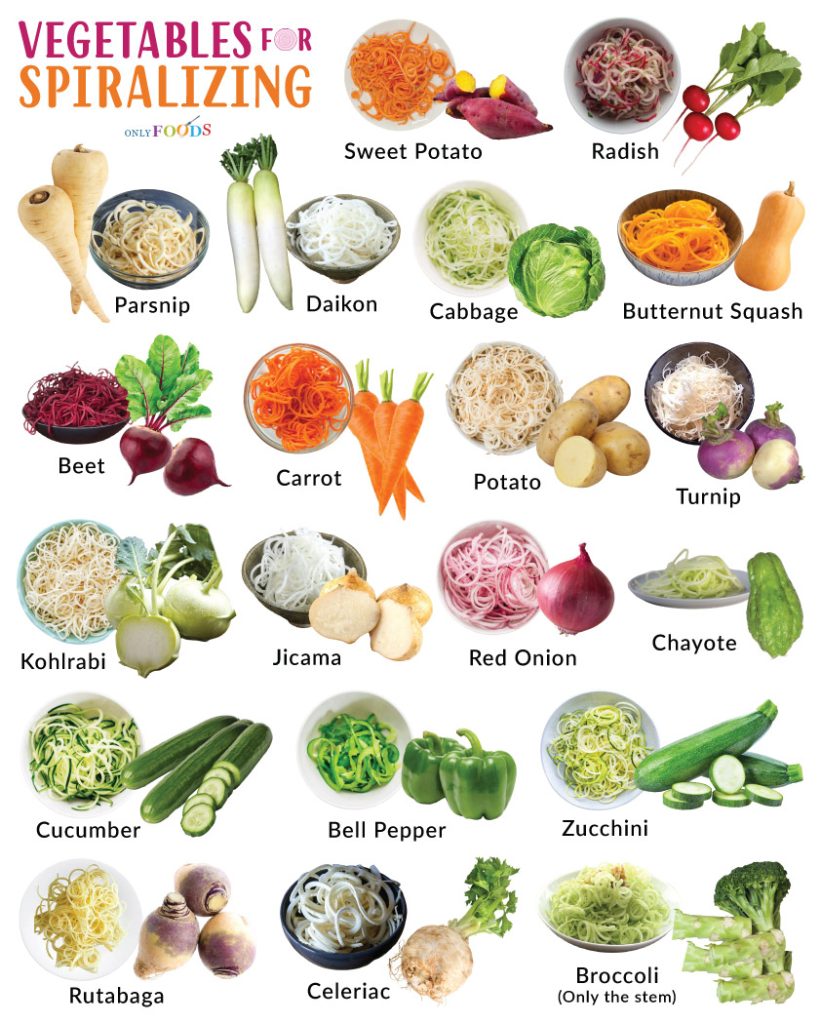Vegetables Good for Spiralizing
Spiralizing vegetables is an easy way to make them more exciting and versatile. They are also a healthier alternative to pasta, noodles, and rice, which is the primary reason for the increasing popularity of spiralizers.
You can do more with a spiralizer than just making ‘zoodles.’ But before getting into what you can do with a spiralizer, it’s important to understand how a spiralizer works.
What is a ‘Spiralizer’
Any tool that can cut or ‘spiralize’ vegetables into noodles can be called a spiralizer. But the term usually refers to the tabletop device with multiple blades and settings that allow you to create thick, thin, and flat noodles (like Kitchenaid).
There are also tabletop spiralizers, probably the most commonly used because they are easy to use and reasonably priced within a $25-$35 bracket. These usually come with 4-5 blades to make noodles, ribbons, and slices out of your vegetables.
Then there are the handheld spiralizers, which often come with 2-3 blades for making noodles and ribbons. These may not be as smooth as a larger spiralizer, but they are portable and more affordable, ranging between $12 and $18.
You can also find a mandoline slicer with spiralizing blades, though you can’t usually control the thickness of the noodles with these.
Here are three spiralizing tools with the highest ratings on Amazon.com.
- Brieftons 5-Blade Vegetable Spiralizer
- Fullstar Vegetable Spiralizer Vegetable Slicer
- KitchenAid Fruit and Vegetable Spiralizer Attachment Stand Mixer
List of Different Types of Vegetables Good for Making Noodles
Vegetables that hold their texture well after cutting and cooking are most suitable for spiralizing. Typical recipes for spiralized vegetables include pasta and noodle dishes, salads, and fries.
Here is a list of vegetables best for spiralizing:
- Zucchini
- Carrot
- Sweet Potato
- Beet
- Cucumber
- Butternut Squash
- Turnip
- Parsnip
- Bell Pepper
- Red Onion
- Kohlrabi
- Cabbage
- Radish
- Broccoli (Only the stem)
- Daikon
- Jicama
- Rutabaga
- Potato
- Celeriac
- Chayote
As mentioned above, spiralizers come with multiple blades to control the thickness of the noodles. All the slicing blades work well for tender vegetables like zucchini and cucumber, so you can choose based on your recipe.
The medium spiral blades work best for root vegetables like beet, turnips, and parsnips, and the resulting noodles look a lot like real spaghetti. For carrots and daikons, the bigger and thicker root would be more convenient to spiralize.
FAQ
Vegetables like eggplant, avocado, and celery are not recommended for spiralizing as they would not hold the texture well when cooked.
Whether you can store spiralized vegetables or not depends on the vegetables themselves. For example, butternut squash and root vegetables like carrots, beets, and parsnips can be frozen and stored for a couple of months. However, those with a high water content, like zucchini, cucumber, and radish noodles, lose their crispness and texture if frozen and thawed.
As long as you use a vegetable that can hold its texture even after freezing, you can freeze the noodles.
Dehydrating spiralized vegetables is a common way of preserving them. Though it is more common to dehydrate zucchini noodles, other vegetables like carrots, beets, and sweet potatoes do just as well. Though the dehydrator time and temperature may vary based on the noodle, it is usually done at 120°F-140°F, taking 4 to 8 hours.

